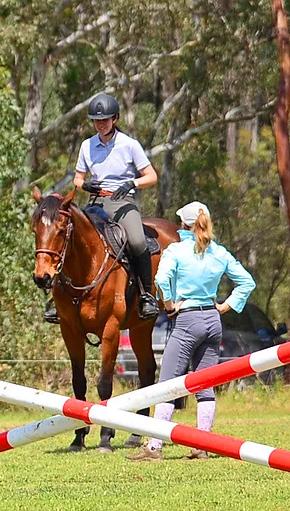
4 minute read
Coaching with Christine: Ready, set, compete
COACHING WITH CHRISTINE
Ready, set, compete
If you’re losing sleep over taking your horse to their first competition, CHRISTINE ARMISHAW has some training techniques sure to help.
The idea of getting your horse to their first competition can be overwhelming and possibly a bit of a ‘hold your breath and see’ type of event. But even though there is an element of the unknown with horses, you don’t have to leave it all to chance.
No matter what your discipline, the point of a competition should be to consolidate and display your training to date, and the preparation should be done well in advance. Thankfully, there is much you can do to set your horse up for success. As their trainer, it’s your job to break the whole experience down into manageable chunks. From your horse’s perspective, there are a myriad of factors at play. Travelling to the venue is taxing; it’s physically tiring for them to stand balanced and stable in a moving horse float, not to mention mentally stressful, especially for an unseasoned equine.
Then once you arrive, there are tons of other horses around, but not a familiar paddock buddy to be seen. People are everywhere, intermingled with strange new sights, smells and sounds. And oftentimes their usually chilled-out rider is acting oddly due to their own tension and nerves. Here’s how to mitigate these unsettling elements.
Desensitisation
Before you even think about setting a hoof off home turf, your first port of call is to create some scary scenarios at home and work through them until your horse is comfortable: walk them over tarpaulins; have a play over poles and around cones; do ground work and ridden work in different paddocks and locations, as well as the arena. Training with flapping flags, bright umbrellas and billowing streamers are all worthy uses of time.
Sound desensitisation can often be overlooked. Accustoming them to a rattling plastic bottle of pebbles, or their least favourite sounds (put together in a YouTube playlist) can go a long way towards keeping them relaxed in the face of new noises. The more novel situations your horse encounters and overcomes, the more they build their confidence, bravery and ability to selfmanage in unfamiliar settings.

Level up at home first
There are lots of additional challenges with having your horse perform well when off-property, and it’s not uncommon to hear a rider say that although their horse goes brilliantly at home, replicating that is hard to do when on show. So make the job easier.
If you are going to your first dressage test, aim to be working one level higher at home. If you’re going out jumping or eventing, aim to be comfortably and confidently jumping ten centimetres higher during training. At a base level, this gives you the advantage of knowing you and your horse are beyond capable of what you are aiming to do in competition.
The caveat here is that if it doesn’t all go to plan on the day, use the experience as a training opportunity. But if you have properly prepared, it is more likely to go to plan.
Stepping stones
Once you’ve done all you can in your own space, take your horse on a few non-competition excursions. Your objective here is to start simple and gradually increase the intensity factor. Hire out an arena with a friend or arrange to meet your coach there for a one-on-one lesson (bonus points for familiarity training if it is an arena that’s likely to be the venue for a competition you may enter in the future). Once your horse is responding well, increase the atmosphere by finding a local riding club, clinic or training day to attend. Strive to amplify the environment a little at a time, without turning up your own tension or nerves.
Once you have a few of these low-key adventures under your belt, you’ll have a pretty good idea of how your horse reacts when in a new place, which again gives you an extra edge when you’re ready to don the white breeches. Keeping yourself level and calm is just as important because it’s true your horse can feed off your energy. What tends to happen when a rider is nervous is that they stop breathing as deeply, which creates tension in the body, hands and legs that the horse can physically feel. However, this too can be overcome by working through the above techniques. The more you know how your horse is likely to react and the more positive experiences you have when out together, the more relaxed you are likely to remain.
Initially your goal should be a good experience, where your horse does as you ask, you both stay composed, and you come home with a smile - only then will ribbons follow. Remember, take your time, breathe deep, and let your preparation pave the way to your first successful competition.
FACING PAGE: Christine’s Intro Jump Clinic makes for a great pre-competition low pressure training day (Image by Olivia Salkeld, Snapshotaustralia). BELOW LEFT: Aim to jump higher during training, which gives you both a confidence advantage when you’re competing (Image by Oz Shotz). BELOW RIGHT:Evelyn desensitising Noble to 'scary' things at home before they go out together (Image by Christine Armishaw).













